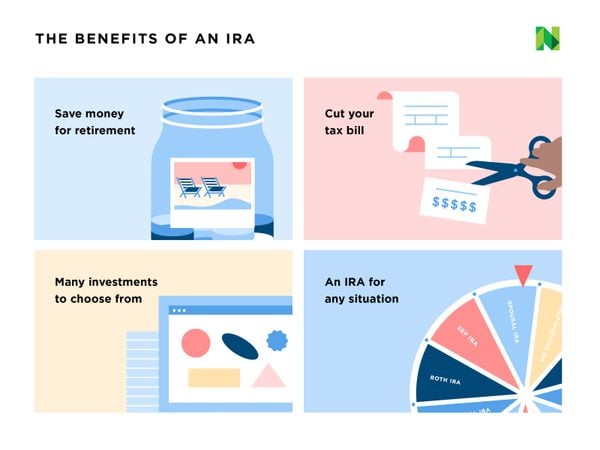Traditional IRA: Definition, Rules and Options
A traditional IRA helps you invest for the future, and could offer tax deductions when you contribute.

Many, or all, of the products featured on this page are from our advertising partners who compensate us when you take certain actions on our website or click to take an action on their website. However, this does not influence our evaluations. Our opinions are our own. Here is a list of our partners and here's how we make money.
The investing information provided on this page is for educational purposes only. NerdWallet, Inc. does not offer advisory or brokerage services, nor does it recommend or advise investors to buy or sell particular stocks, securities or other investments.
What is a traditional IRA?
A traditional IRA is an individual retirement account that takes pretax contributions. Depending on eligibility, these contributions could be tax-deductible, though withdrawals made during retirement will be subject to income tax.
There are many different types of IRAs and various options for where to open an IRA account, such as an online brokerage, a robo-advisor, or bank.

How does the traditional IRA work?
The traditional IRA works by allowing account owners to contribute pretax dollars to be invested for retirement (See how to invest your IRA for simple investment tips.).
The main draw of a traditional IRA is that for those who qualify, contributions are tax-deductible, resulting in a tax break for that year. Withdrawals in retirement, however, are subject to ordinary income tax. You must reach age 59 ½ to withdraw from your IRA account without incurring penalties.
There are annual contribution limits when it comes to IRAs. You can contribute up to $7,000 in 2024 and in 2025, even if you’re also contributing to a 401(k) or other workplace savings plan. Those age 50 or older can contribute an additional $1,000 each year.
Generally, you (or your spouse) must have earned income to contribute to an IRA. You can also add to your IRA by rolling over money from another retirement account.
NerdWallet rating 4.8 /5 | NerdWallet rating 4.6 /5 | NerdWallet rating 4.5 /5 |
Fees $0 per online equity trade | Fees $0 | Fees $0 per trade |
Account minimum $0 | Account minimum $0 | Account minimum $0 |
Promotion None no promotion available at this time | Promotion Earn up to $10,000 when you transfer your investment portfolio to Public. | Promotion Get up to $700 when you open and fund a J.P. Morgan Self-Directed Investing account with qualifying new money. |
Traditional IRA: Pros and cons
While there are many benefits of a traditional IRA, it's important to remember the limitations. Here are some of the pros and cons:
PROS | CONS |
|---|---|
There are no income limits to open and contribute to a traditional IRA. | If you tap the money before age 59 ½, you’ll pay taxes and a 10% early distribution penalty, unless your withdrawal qualifies as an exception. (Here’s a full list of the traditional IRA early distribution rules.) |
If you're eligible for the tax deduction on contributions, you can claim it whether or not you itemize deductions on your tax return. | You must begin taking distributions — called required minimum distributions — at age 73. (There are no required minimum distributions with Roth IRAs.) |
Tax-deferred growth means any gains you would pay taxes on in a standard brokerage account are pushed down the road. | If you're covered by a retirement plan at work, your ability to deduct IRA contributions may be reduced or eliminated at higher incomes. |
You can use traditional IRA money to pay for qualified college expenses without paying an early distribution penalty, although you'll pay taxes on the distribution. | |
You can use up to $10,000 from a traditional IRA toward the purchase of your first home (again, you’ll owe taxes on the distribution but no penalty). | |
You pay regular income tax on distributions from your traditional IRA. See what tax bracket you're in |
How to open a traditional IRA
To open a traditional IRA, decide what kind of investor you want to be — hands-on or hands-off.
Hands-on investing. If you want to choose your own investments, you might consider an online broker. With a broker, you’ll select from investments accessible through that provider, including stocks, bonds and mutual funds.
Hands-off investing. If choosing your own investments sounds too daunting, consider the hands-off approach with a robo-advisor. These providers, which now include many of the most recognizable names in investing, use automated technology to choose investments based on your goals and investing horizon for a fraction of what a traditional investment manager might charge.
» Find the best IRA account for you
Who is eligible for a traditional IRA?
The good news: Everyone can open and contribute to a traditional IRA. The bad news: Not everyone is eligible to deduct contributions and reap the tax benefits of a traditional IRA.
Qualifying for a traditional IRA when you have a 401(k) or other employer plan
If you or your spouse has a retirement plan at work, the amount of your traditional IRA contribution that you can deduct is reduced, or eliminated altogether, once you hit a certain income. You can still make contributions, but they won’t be tax-deductible.
If you, and your spouse if you're married, don't have retirement plans at work, then you can deduct your IRA contribution no matter how much your income.
Note: The income limits apply to your modified adjusted gross income (MAGI), which is your adjusted gross income with some deductions and exclusions added back in. See IRS Publication 590-A, Worksheet 1-1, for complete instructions on figuring MAGI for traditional IRAs.
Traditional IRA limits in 2024
These income limits apply only if you (or your spouse) have a retirement plan at work.
Filing status | 2024 traditional IRA income limit | Deduction limit |
|---|---|---|
Single or head of household (and covered by retirement plan at work) | $77,000 or less. | Full deduction. |
More than $77,000, but less than $87,000. | Partial deduction. | |
$87,000 or more. | No deduction. | |
Married filing jointly (and covered by retirement plan at work) | $123,000 or less. | Full deduction. |
More than $123,000, but less than $143,000. | Partial deduction. | |
$143,000 or more. | No deduction. | |
Married filing jointly (spouse covered by retirement plan at work) | $230,000 or less. | Full deduction. |
More than $230,000, but less than $240,000. | Partial deduction. | |
$240,000 or more. | No deduction. | |
Married filing separately (you or spouse covered by retirement plan at work) | Less than $10,000. | Partial deduction. |
$10,000 or more. | No deduction. |
Should I contribute to a traditional IRA if I can’t deduct it?
Nondeductible IRA contributions can still be valuable: Money for retirement is money for retirement, and your investment earnings will still grow tax-deferred. But this can also be a headache: You are responsible for keeping track of after-tax contributions by filing IRS Form 8606 each year so you’re not taxed again on that money when you take retirement distributions.
In short, there are better options you should max out before going down the nondeductible IRA road. They are:
A Roth IRA, if you’re eligible. These accounts have income eligibility rules, but they are higher than the limits to deduct traditional IRA contributions. See our Roth IRA limits page.
Your employer-sponsored retirement plan. Consider maxing that account out before making nondeductible IRA contributions. That could actually make you eligible for an IRA deduction because your contributions to the workplace plan lower your taxable income for the year.
If after exhausting both of those options, you still want to consider the nondeductible route, see our page on nondeductible IRAs.
Other types of IRAs
The are other popular types of IRAs out there, too. Some cater to self-employed individuals, while others may be a good fit for spouses who don't work but would like to bolster their retirement savings:
Roth,
SEP,
Self-directed, and
You can learn more about each of these in our guide to IRAs.
FAQs
On this page
On this page





